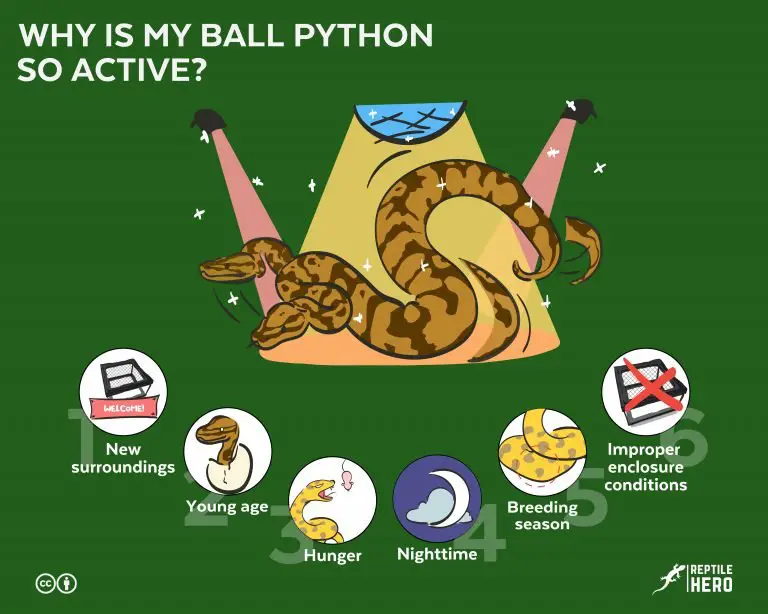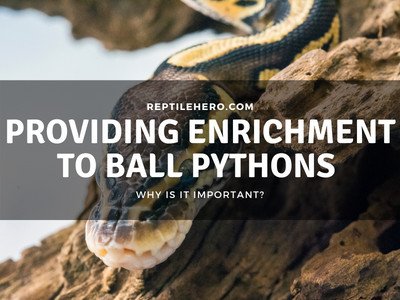Can You Use a Fish Tank For Ball Pythons? Here’s Why!
Do you have an old fish tank that you want to use for a ball python? Is it suitable for this kind of snake? Enclosures can improve a ball python’s quality of life, but some can also cause harm to it—are fish tanks one of the dangerous options?
A fish tank can be used as a ball python enclosure as long as it is compatible, appropriately sized, in good condition, and has well-adhered panels. Tanks are readily available, spacious, and see-through. However, they can also be heavy, expensive, and not secure enough for a ball python.
Ball pythons are one of the most improperly kept pets in the reptile community. Can fish tanks be a great enclosure for them? Can you use a fish tank as it is? If not, can you modify it? Learn the answers to these questions as you read below!
4 Factors to Consider in Choosing a Fish Tank for Ball Pythons
Before purchasing a fish tank to use as a ball python enclosure, consider the following factors: 1) compatibility, 2) size, 3) condition, and 4) adhesive.
As long as you make sure that each of these are properly considered and accounted for, you can use a fish tank as a ball python enclosure!
1. Compatibility
Fish tanks can be used as a ball python’s enclosure. However, it is important to consider its features, especially the lid, to determine that it’s compatible with a snake.
There are fish tanks that would not be compatible with ball pythons because they are not that secure. In other words, snakes will find it easy to escape!
So if you want to use a fish tank, make sure that it has a lock on the lid or you can put a lock on it. Fish tanks will also be easier to use or modify if it already has a screen lid.
However, if the tank has a plastic lid with no holes, then modifications for ventilation and locks are needed.
Other fish tanks will be harder to fit with a custom lid due to having features like curved glass walls. So please avoid curved aquariums as they might not be applicable for ball pythons.
2. Size
Fish tanks are available in a variety of sizes that can fit a ball python. However, certain ones may seem optimal when they are actually not because they are too narrow.
| Gallons | Size (Inches, LxHxW) | Ball Python Size (Inches) |
| 20 | 25 x 17 x 13 | 12–24 |
| 30 | 30 x 19 x 13 | 24–36 |
| 40 | 36 x 19 x 15 | 36 |
| 50 | 48 x 19 x 17 | 36–60 |
| 75 | 50 x 21 x 19 | 60–72 |
The measurements above are not exact and are not applicable for some fish tanks. But as you might have noticed, most of the time, a fish tank is taller than its own width since it is made for fish and not reptiles.
As mentioned, there will be fish tanks with a narrow width. But you can use the dimensions indicated above as a general reference for buying a great fish tank for ball pythons of all sizes.
The minimum enclosure requirement for a ball python is for it to be able to stretch fully along 1 side or by 2 sides of the enclosure.
3. Condition
Before purchasing a fish tank for ball pythons, check for any cracks and unsealed parts in areas like the sides and lid. |This is to ensure the safety of the snake that will be housed inside.
A small crack might grow to an even bigger one. Meanwhile, a poorly adhered tank might break especially during cleaning and relocation.
Cracks in fish tanks can be easily distinguished and should always be inspected before buying it within the store.
But how can you spot a poorly adhered tank?
A poorly adhered fish tank will have gaps and broken adhesives like silicone and sealers at the corners–where the glass panels are joined.
You can also touch the adhesive. If it feels brittle and crusty, then it might be an old adhesive that can crack easily under pressure.
4. Adhesive
The most common adhesive used for fish tanks is aquarium-safe silicone which is not toxic to ball pythons if allowed to cure completely for at least 24 hours. Be wary of any wet adhesives which can cause injuries like scale removal to the python.
Aquarium adhesives are often called aquarium silicone or aquarium sealant and can come in different colors like clear, black, and blue.
Fish tanks are generally safe for a ball python in terms of their adhesive. Because a silicone aquarium sealant will not be toxic in contact when it is dry.
However, there are cases where a fish tank is sold right after it has been made. In such cases, the rule of thumb will be to wait for the adhesive to cure for a minimum of 24 hours.
Ball pythons are not aquatic snakes, so cured silicone will have no effect on its health since it will not stay underwater. Most of the time though, cured silicones are safe even for aquatic pets like fish.
3 Advantages of Using a Fish Tank as a Ball Python Enclosure
Fish tanks are great enclosures for ball pythons because of their: 1) availability, 2) space, and 3) visibility.
1. Availability
Fish tanks are the most common kind of enclosure sold in most pet stores. This is because compared to ball pythons, fish, in general, are more popular in the pet-keeping hobby.
So if you are looking for an immediate ball python enclosure, fish tanks will be the safest bet besides plastic bins. As long as there are pet shops near you, the chances of finding and buying a fish tank are pretty high.
There are also many brand-new and second-hand fish tanks for sale online. Sites like Amazon, Craigslist, Classified ads, eBay, and many more offer a large variety of fish tanks.

So if you are going to a regular pet store, you will most likely see more fish tank options than reptile terrariums.
2. Space
On average fish tanks are available in many sizes that can accommodate ball pythons of different sizes. Although 20-gallon tanks are the most common, fish tanks can get bigger than 100 gallons.
In addition to ample floor space, most fish tanks are also tall which can actually provide you with enough headroom to cater to climbing enrichment for a ball python.
Contrary to what other keepers say, ball pythons “can” climb and this activity stimulates their brain!
Even though they are primarily terrestrial snakes, ball pythons should still be provided with ample space for exploration—not only horizontal but also vertical areas to climb.
Keepers that forced the idea of ball pythons “not benefitting” from climbing space are those that are keeping their snakes in short and barren enclosures.
One study shows that there are significant differences between a snake kept in a minimal setup compared to one that is kept in a nice one [1]. For example, snakes given enrichment can distinguish their owners better.
3. Visibility
In general, fish tanks have glass sides that allow owners to easily and clearly see inside. This also lets light pass through to provide additional lighting for the ball python’s night and day cycle.
In addition to the benefits of clear views and lighting, fish tanks are also aesthetically pleasing to look at. Most have flush sides, while larger ones can have different supports that are fitted to their edges, which some keepers prefer.
Fish tanks can be a centerpiece in your home when placed correctly. I notice that keepers who use fish tanks display theirs on top of a cabinet or shelves of the same length.
So if you want to use an enclosure that is easy to acquire, has many sizes, allows viewing, and looks good, then a fish tank might be a good alternative.
3 Problems of Using a Fish Tank as a Ball Python Enclosure
Fish tanks might not be the best option for ball python enclosures due to its: 1) weight, 2) upfront costs, and 3) security.
1. Weight
Fish tanks are heavier in comparison to plastic, PVC, and wooden enclosures. It’s generally heavy because thick glass panels are required to keep it water-tight. This can make cleaning the enclosure difficult.
| Capacity (Gallons) | Weight (Pounds) |
| 20 | 25 |
| 30 | 40 |
| 40 | 58 |
| 50 | 85 |
| 75 | 135 |
Aside from thick glass, a fish tank can become even heavier if it has wooden or metallic supports on its sides.
I personally had a hard time with the current enclosure my ball python, Choco, has–a fish tank. It’s quite big, measuring 3x2x2 ft in measurements. Due to its size, I find it hard to carry and move it around for cleaning.
Even though I had this tank custom-made, all of its sides are made up of glass with aluminum supports. So its weight will more or less be similar to an empty 70–75-gallon fish tank.
2. Upfront Costs
In most cases, fish tanks are quite expensive. 20–75-gallon fish tank cost roughly 100–300 dollars, without the necessary modifications. Ultimately a converted fish tank enclosure will cost even more than custom-made enclosures made from PVC or wood.
The price range indicated above is generally applicable to store-bought and branded ones. There are enclosure makers that can build custom-made glass enclosures for less or even half the average store-bought price.
Although fish tanks can be used for a ball python enclosure, there are better alternatives within the same price range.
Custom-made PVC and Wooden enclosures can cost more or less 150–400 dollars.
A great enclosure for ball pythons is this one by Zen Habitats. It provides ample horizontal and vertical space while providing an excellent view inside. It can also be assembled easily after you have received the shipment.
3. Security
Most fish tanks have unsecured lids or no lids at all since they are made for fish and other aquatic pets. In addition to this, it also opens up from the top which might stress out a ball python.
With most having a “clipping” lock mechanism, a fish tank’s lid can easily be pushed by a ball python, especially a large one.
Some fish tanks even have no locks or no lids at all which is not a great feature to prevent ball python escapes!
>>Learn more about a ball python trying to escape in our article about ball pythons escaping
Fish tanks also open from the top so ball pythons can also feel threatened. Remember, predators like birds typically approach and capture them from above.
So they can associate your hands coming to get them from above as birds of prey that are about to grab them.
The most common predators of a ball python in the wild are birds of prey, predatory mammals, and even other ball pythons.
Modifications to a Fish Tank Enclosure for Ball Pythons
To make a fish tank a suitable enclosure for a ball python, it can be modified in 2 ways: 1) adding a lockable lid and 2) front-opening conversion.
If these modifications are done, you can keep a ball python in an appropriately sized fish tank for long-term use.
1. Adding a Lockable Lid

In this section, the fish tank must have a center brace on top of it to accommodate the lid.
Here are the steps to create a secure lid for a ball python:
- Gathering the materials needed. The following materials are needed:
- Fiberglass mesh (At least 5×5 ft)
- Screen framing like this on Amazon
- Screen rolling tool like this on Amazon
- 2 pcs handle
- 4 pcs. 2–3 mm thick Acrylic strips (around 10×25 mm)
- 4 pcs. screws
- Measuring the frame size. Measure and cut the screen framing to size using a hand saw. Make sure that you are measuring the area of the brace it will be placed on.
- Creating the mesh top. Use the rolling tool to secure the fiberglass mesh into the frame. Then cut any excess mesh after being secured.
- Securing a small handle for each screen. Handles can be secured using silicone or super glue on one side of the screen framing. This is important to easily remove the lid when needed.
- Installing the acrylic strips. The 4 strips should be secured using 1 screw each on the bracing frame of the tank. These acrylic strips will serve as a rotating lock or “stopper” to prevent the ball python from pushing up the lid.
2. Front-Opening Conversion
As another modification, a fish tank can also be converted into a front-opening enclosure for a ball python. However, this is not recommended for those with no experience working on glass.
Working with glass can be quite dangerous as a simple shard can cut through the skin easily. So cut-proof gloves are always a must when cutting and installing glass.
You can convert a fish tank by removing its front panel and installing metal framing and sliding door rails. Silicone will be the primary adhesive for this process.
For the sliding door itself, you can use an acrylic or glass sheet and make sure that the panels have their edges sanded down due to their sharpness. Do not forget to add handles and a sliding door lock!
If you do not want such a tedious process, there are tank conversion kits like this from Frog Cube. With these kits, installation is very easy. However, the sizes available are limited. They can only work on 20–40 gallon tanks.
Difference Between a Fish Tank and a Reptile Tank
In most cases, reptile tanks have front-opening doors while fish tanks only have an opening at the top. Fish tanks are designed for aquatic animals while reptile tanks are designed for terrestrial and arboreal animals.
Aside from the features mentioned above, reptile tanks are also generally more expensive due to additional features like framing, cross ventilation, and so on. Reptile tanks can also have either sliding or swing-type doors.
Reptile tanks are also wider in comparison to fish tanks of similar lengths.
Fish tanks, on the other hand, can be rimless or only have support at the top and base due to not having a front opening. They are also taller in comparison to terrestrial reptile tanks of the same size.
Further Questions
Where do ball pythons live in the wild?
Ball pythons are often found in rodent burrows and termite mounds. They originate from the Sub-Saharan region in Africa.
Do ball pythons prefer a certain kind of enclosure?
There are no scientific studies that confirm whether or not a ball python prefers any enclosure material—plastic, PVC, wooden, or glass. But a ball python will live happily in an enriched environment with ample space for hiding, climbing, and exploring.
Summary of Using Fish Tanks as a Ball Python Enclosure
Fish tanks can be used as enclosures for ball pythons. But it is important to consider whether or not it is compatible, has a suitable size, is in great condition, and has all panels adhered properly. To modify a fish tank, there are 2 options: creating a secured lid and converting it to have front-opening doors.
Fish tanks can be used as a ball python enclosure due to being readily available, having appropriate sizes, and having clear sides for optimal viewing. But there are also disadvantages like heavyweight, expensive upfront costs, and lack of security.
The main difference between a fish tank and a reptile tank is in their openings. Fish tanks open up at the top while reptile-specific ones open at the side. Reptile tanks are typically more expensive due to additional features.
Sources
[2] https://www.sciencedirect.com/science/article/abs/pii/S0168159113001214






